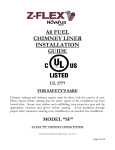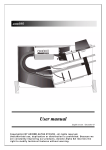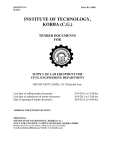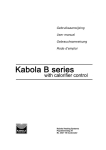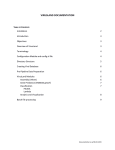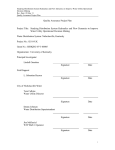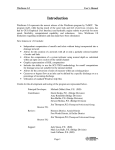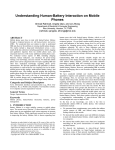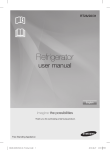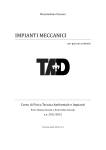Download EL60-72 – User`s Manual – v.14.0 ENG Elifrance
Transcript
PHOTO OVOLT TAIC MODULE ES SER RIES EL E 60 A AND EL L 72 Manu ual forr the Sa afety, In nstalla ation, Use, U Ma aintena ance, W Warranty y and Dispos D sal ELECTRIC C EQUIPMENT – CONSULT A PROFESSION NAL PHOTOVO OLTAIC SYSTE EM INSTALLER R ELIFRA ANCE. EL series phhotovoltaic modules have been designed to generate eleectricity in DC from solar energy This manual contains c important information for the safety, s installation, use, maintenance, warranty and dispposal of the modulees It is strictly recommennded to keep and read r it carefully befoore the installation,, use and all other aactivities The installer andd the user of the moddules are the only respponsible for the respecct of all local authorizaations and legal regullations connected withh the installation of the moddules. No responsibillity can be attributed to t the module manufaacturer for the non-obsservance of the appliccable regulations and the instrucctions contained in thiis manual INSTALLATIO ON SAFETY RE EGULATIONS FORMATION GENERAL INF Before performing any module instaallation, wiring, operation and maintennance, it is necessary to acquuire all the instructioons required for thee installation and saafety of the whole photovoltaic (PV) system. During the installation, it is compulsory to adhere too all regulatory requirements established by locaal, regional and natioonal directives, laws and instructions. Installation and maaintenance must be performed p only by authorized company. Broken or damaged modules must be carefully handled annd disposed in accorrdance with current regulationss. Broken glass can be sharp- edged and cause wounds if not n handled with appropriate prrotective equipment. Photovoltaic modules produce voltage even when not connnected to an electriccal circuit or load. Photovoltaic modules generate a voltaage value close to thhe open circuit even when they are exposed to soolar radiation and evven for just 5% of thheir surface; furtherrmore, both electrical current annd power increase with w the intensity of the incident light. Standard rated speecifications of the seector are established in conditions of irrradiation of 1000W/m2 and 255 °C (A.M. 1,5) tempperature. Lower temperatures can greattly increase both voltage and power. Make sure that thee modules are subjeect to ambient tempperature between- 40°C 4 and + 80°C. Thermal exxcursions larger thhan these specifiedd may severely deegrade the efficiency and compromise module useeful life. Snow, water or othher surfaces reflectioon can intensify solaar light thus increasinng both the current and the poower generated by the t module. It is strrictly important to coonsider this when sizing the sysstem. NEVER convey artificially sunlight on the module with mirrors, lenses, screens or other means. a manufactured exclusively e for outdooor use in a The EL series moddules are designed and system designed, assembled and installed i by professsional installers, qualified q in accordance with laaw, for permanent use at a predefined location l and for the production of energy from solaar light for public, commercial, industrial and residential applications. Photovoltaic modules are not designedd for indoor use or application a on movinng vehicles mitation, there are innstallations of any kind. Amonng the excluded appplications, without lim where modules coome into contact witth salty water or whhere they can be sw wamped in whole or in part by salty or fresh water,, such as on boats, jetty and buoys. Use only equipmeents, connectors, wiring and support fraames specifically deesigned for photovoltaic system m. In normal conditionns, photovoltaic moddule may produce more m current and / orr voltage as indicated in standaard conditions. Therrefore the ISC and VOC V values shown on module label should be muultiplied by a factor of o 1.25 to determinee the maximum tolerable value of the components of the installationn, related to voltage, current, conducttor section, fuses, and size of controls c connected to t the output of the photovoltaic p generatoor. MODULES HA ANDLING SAFE ETY REGULAT TIONS Do not use junctionn box and cables to grab or transport thee module. Do not step on thhe module, do not drop d the module annd not to drop objeects on the module. Do not damage or scratch the rear surfface of the module. c the modulee on any surface, particularly when plaacing it in a Always put down carefully corner. Do not disassemble, modify or adapt the t module and do not n remove any part or labeling installed by the maanufacturer. This will void the warranty. Do not punch hole in the frame, in the glass surfaces or in the front or rear surffaces. m as well as on the back Do not apply paint or adhesive on thhe surface of the module surface, this will vooid the warranty. Never leave modulle without any suppoort or unsecured. A module with broken glass or with daamaged back surfacce can neither be reepaired nor used. Contact withh any part of the innner parts of the moddule or the frame caan produce electrical shock. Work only under dry d conditions usingg only dry tools. Nevver handle moduless when are wet. p page 1 of 4 Do not perform moodules installation in presence of strong wind. w It is necessary thee use of appropriatte safety procedures and protective eqquipment provided by the system s designer too avoid falling or other o safety hazardds when installation is perfoormed at high points.. Photovoltaic moduules do not have the on / off switch. To T disable the modules it is necessary to movee them away from ligght or completely coover the front surfacee with an opaque material, or o by working with moodules face down onn a smooth, flat surfaace. When working on the t modules exposeed to sunlight, it is necessary n to complyy with the current regulationss regarding the handling of electrical equuipment. Do not touch the electrical terminals or cable ends durring the installation or when module is exposedd to sunlight. Never open electriccal connections (junnction box) or unplugg connectors while thhe circuit is live or the modulles are under sunlighht. Do not insert anythhing in the current coonductor connectors Contact with moduule electrically activve parts such as terminals can result in i burns, sparks and lethal shock s whether the m module is connected or disconnected. Always use insulaated tools and rubbber gloves approveed for working on electrical e installations. Y REGULATIONS FIRE PREVENTION SAFETY Check with local authorities for guidelines and requiremennts for fire safety of buildings or structures. The installation of the modules on a rroof, could affect thee conditions of fire safety s or structural stability. Before the installaation it is important to verify with the loocal Fire Authority the necessity to prepare a coovering of the roof, certified and resistaant to fire according with the local regulations. Do not use moduules close to equipm ment or locations where w can be geneerated or collected flammable or explosive atmospheres. ELECTRICAL L INSTALLATIO ON GUIDE The maximum opeen circuit voltage m must not exceed thee maximum system m voltage specified for the moodule. All modules are equipped with faast connectors andd cables installed by the manufacturer. The modules are designned to be easily connnected in series. Only use cable typpe, section and connnections approved foor photovoltaic use and a sized for the maximum short-circuit currennt of the module when w the system haas to be connected. It shouuld be used at least cables with 4 mm2 copper wire, insulaated for a minimum of 90°C and a sunlight resistannce with insulation designated as PV Wire. When making connnections, match thee polarities of cablees and terminals, otherwise o irreparable damagee to the module can occurred Module is equippeed with bypass diodees installed by the manufacturer and set s inside the junction box. The junction box is noot designed or certiffied to ensure accessibility or s and can under no circumstancess be opened. Opening the maintenance on site junction box may void v the warranty. Inverters not equippped with transformer do not arrange galvanic g separation between AC-DC side; it is suggested to keep in mind this for groundding in order to be compliant c with the IEC standaards • Warning: Thhe connection of the modules with reverse polarity too a source of high-power current, like a batteryy, will destroy the bbypass diodes andd makes module unnusable. Byypass diodes cannoot be replaced by thhe user. ed.14.0 - june 2015 © ELIFRANCE sas. PHOTO OVOLT TAIC MODULE ES SER RIES EL E 60 A AND EL L 72 Manu ual forr the Sa afety, In nstalla ation, Use, U Ma aintena ance, W Warranty y and Dispos D sal ROUNDING SY YSTEM GUIDE GR (Va alid for connection n to the power sup pply in the EU cou untries) Photovoltaic modules are electrical prooducts "Class 2" (Doouble Insulation) Although photovolltaic modules do not n require a framee grounding system m, the local or national regulationns of the place off installation may require this devicee for electrical protection purposees, for example caussed, but not necesssarily, by lightning. For F this reason the module is dessigned for groundinng through small metal m screws (not supplied) s to be coupled into a holee in the mounting frame. The suitability and efficiency of the grrounding system muust be first verified by the installer before the connecttion of the modules. Direct grounding syystem means the dirrect connection between ground and the metal parts of the module (mouunting frame) withouut the use of a resistor. Follow the specific directions regardding the direct grouunding pole DC prrovided by the supplier of the inveerter used. These inddications depend onn the brand and the specific type of inverter to be used in the plant. The grounding sysstem must be able too carry at least 125% % of the short-circuit current of the group (Isc). The protection class 2 is granted on the condition that all a components andd seat used for grounding are provvided with certificatioon of Class 2. According to the international standdard IEC 60364, section 712.312.2, active wiring grounding on the DC side of a groupp is granted on thee condition that elecctrical isolation between the AC and a the DC side of the t inverter are founnded. The inverters equipped with transformer have galvanic isolation between the AC and DC sides thuus making the performance of thhese devices in grroups with photovooltaic electrical grouunding system compatible with thee IEC standards. nnecting the modules m in serie es Limit of con Must be conneccted in series only identical PV modulees that is to say moodules of same typee and same power class. c When conneccted in series, be caareful not to exceedd the maximum allow wable voltage of the system. It is compuulsory to pay attentioon to the temperaturre dependence of thhe voltage of the moodule, especially beecause the module voltage v increases inn case of lower tempperatures. Consequeently, modules may be connected in seeries up to the achieevement of this voltaage. The connecting cables must m be appropriatelly sized for the voltage values achieved. The maximum voltage of o the system allowedd by the inverter must not be exceeded for f any reason. Therrefore, due to the negative temperaturee coefficient of the PV P modules, it must be calculated the open o circuit voltage of the entire system m at the lowest posssible temperature (ssee data sheet and plate of the module)) A MAINTEN NANCE USE AND onnecting the modules in parallel Limit of co It can be connected in parallel all the modules comppatible with the inverrter, or with the equippment on which theyy should be interlinkeed. It will be necessary to usse cables having a suitable s cross sectioon for the driving of the sum of the curreents generated by the single module. The conductor c to be usedd shall not, howeverr, have a lower sectioon than 8 mm2. The installation of photovoltaic modulees must maximize thhe direct exposure to t sunlight and eliminate or minimiize the presence of shadows. s Even the presencee of some areas of shade s on the surfacee of the module can greatly reduce the production of energy both for the module m and the systeem. Modules must be securely fastened using support framees or specific kits of o supports for photovoltaic applications. The mounting methhod does not block the t module drainagee holes. The module framee must be connecteed without wringing the substructure prrofiles (support profiles) in conform mity with the approprriate fixing holes on the long side. In genneral, the fixing on the short side off the frame is not allowed. The modules can be b installed at any anngle with an orientattion from portrait to laandscape. The accumulation of dirt on the surfaace of the module can c cause shadow on o photovoltaic cells and cut the electrical efficiency. For over the roof innstallation, it is impoortant to provide an adequate ventilationn of the bottom of the modules in order o to cool temperaature down (minimum m space 100 mm). It is necessary to leave a space of at least 10 mm betweeen adjacent modulees to allow the thermal expansion of the frames. Modules must not be covered by watter. Should be avoidded the accumulatioon of rainwater and thaw. Keep the back surrface of the modulee free from any foreeign objects or strucctural elements which could come into contact with thhe module, in particcular when it is undder mechanical load p page 2 of 4 It is not required routine mainteenance. However, it is advisable to carry c out periodic inspections to verify poossible damages too glass, back-sheett, frame, junction box annd external electricall connections. Verify the abseence of electrical connections lack or coorrosion. The photovoltaaic modules grant eefficient performancces even in the abssence of washes; howevver, the presence oof dirt on the front gllass can significantlyy cut the production of energy. e EL photovoltaicc modules series usse front glass equippped with a resistant, durable and anti-reflecttion surface designeed to improve electriccal performance. It is possible too wash or rinse with water the coated froont glass to remove dust, dirt or other depossits. Do not, under any circumstances, use chemicals or harsh or abrasive cleanners on the front glaass. Do not use alkkaline substances, including solutions contaaining ammonia and acids. During maintennance on the modulees exposed to sunligght, it is necessary too comply with the curreent regulations andd safety cares regaarding the handlingg of live electrical equippment. Do not touch the electrical terminnals or cable ends and never open electrical connections (junctioon box) or unplug coonnectors. Photovoltaic module do not have thhe on / off switch and generally it is connnected in o modules. Befoore any maintenancce operation on the module m it the plant with other is necessary too move them away ffrom light or compleetely cover the front surfaces with an opaquee material and checkk the absence of danngerous voltage. BILITY LIAB ALLATION GUIDE MECHANICAL INSTA Walking on the modules can cauuse irreparable dam mage. Such damagge is not covered by thee warranty upon the pproduct and perform mance. It is necessary to make sure that m modules are not subjjected to wind or snoow loads exceeding the maximum permitteed loads and are not subjected to excessive e forces due to thhermal expansion off the support frame. It must be avoided any exposure tto water and / or floooding of the back surface of the module. The frame of thhe module has eightt 9x14mm mounting holes to secure the modules to the supporting structure. To reaach the nominal mechanical resistance,, use, for the fixing, at least the four mounnting holes farther from the short sidees of the frame. Secure the module in each fixing location with an M8 mm bolt, flatt washer, spring washerr and nut. Then tiighten to a torquee of 16 Nm. It is strongly recommended the use of corrosionn proof fittings (stainlless steel). In case of use of clamps to fix the module on thee supporting structuure, it is recommended to comply with the instruction provided by the supplier of the t fixing system in addittion to the instructionns present in this maanual. Since the use of this manual andd the conditions or methods m of installation, use, maintenance and a disposal of thee modules are beyond the control exxerted by ELIFRANCE, the t company does not assume any liaability and explicitly disclaim any responsibbility for loss, dam mage, injury or exppense arising out of or in connection witth such installationss, operation, use, maintenance m and dissposal of the module. All the informattion in this Manual aare result of knowleddge and experience acquired by ELIFRANCE E and are reliable; ssuch information, foor example indicativee product specifications and a suggestions doo not constitute warranty, expressed orr implied. ELIFRANCE reeserves the right to make changes to thhe product, specifications or this manual witthout any notice. RTIFICATIONS S CER The T manufacturer asssures that the mannufacturing of the photovoltaic moduless is done according a to the folloowing international: ISO 9001 Quallity system managem ment certification of the t manufacturing site. ISO 14001 Environmental system management certiffication of the manufacturing site. OHSAS 18001: Health and Saffety system managgement certificationn of the manufacturing site. Product certificcate according to IEC C 61215 edition 2 e IEC 61730-2 Class A Fire Reaction Classification: B-s22-d0 according to EN E 13501-1 and ”C Classe 1” according to UNI 9177 ed.14.0 - june 2015 © ELIFRANCE sas. PHOTOVOLTAIC MODULES SERIES EL 60 AND EL 72 Manual for the Safety, Installation, Use, Maintenance, Warranty and Disposal WARRANTY Elifrance EL photovoltaic modules series are covered by the following warranty clauses: CLAUSE 1: 10 years warranty against manufacturing defects. Elifrance grants that its photovoltaic modules, the MC connectors and cables assembled in the factory are free from defects in materials and manufacture under conditions of installation, use and applications for a nominal period of 10 YEARS from the date of sale (attested by the bill of sale). In case of modules dissimilarity observed within the aforementioned 10 years, ELIFRANCE at its own discretion, may take charge of repairing or replace the faulty products. The repairing or replacement shall constitute the only form of compensation provided by this clause and it cannot be extended beyond the aforementioned 10 years. Repairing or replacement will be due only to the final customer. This clause does not constitute, in any way, a form of guarantee about the power supplied by the photovoltaic module. CLAUSE 2a: 10 years warranty on power peak output. If within a period of 10 years from the date of sale (attested by the bill of sale) a photovoltaic module should exhibit a power output lower than 90% of the minimum contractual output power (it refers to peak power at STC condition, cutted tolerance down), ELIFRANCE, at its own discretion, might proceed with an integration of photovoltaic modules or a replacement of faulty ones to the final consumer in order to recover the power lost. CLAUSE 2b: 25 years warranty on power peak output. If within a period of 25 years from the date of sale (attested by the bill of sale), a photovoltaic module should exhibit a power output lower than 80% of the minimum contractual output power (it refers to peak power at STC condition, cutted tolerance down), ELIFRANCE, at its own discretion, might proceed with an integration of photovoltaic modules or a replacement of faulty ones to the final consumer in order to recover the power lost. The actions described in clauses 2a and 2b are the only form of compensation provided for the lost of peak power. Peak Power at STC conditions The peak power at STC conditions is the peak power expressed in Watts that the new photovoltaic module generates at its maximum electrical power point and it is stated on the label. The test standard condition (STC) are: a) Light spectrum AM 1.5 b) irradiance di 1000W/m2 perpendicular c) cell temperature 25°C The measurements are made on the output connectors, in accordance to IEC 61215. WARRANTY LIMITATIONS All guarantee application instances must be submitted during the warranty coverage period. Guarantee clauses 1 and 2 will not apply, and ELIFRANCE will not be liable for any obligation toward photovoltaic modules that have been subject to: • Improper, incorrect, negligent use or accident during their use. • Alterations, improper installation or application. • Non-compliance with this instruction manual • Repairing or modification by parties not explicitly authorized by ELIFRANCE. • Discharge from failure, flood, fire, lightning and any other event that is beyond ELIFRANCE control. 3. After a period of 25 years from the date of sale (attested by the bill of sale) is not possible to appeal to clauses 1 and 2 even to cover the cost of shipping, customs clearance and any other charges for the restitution of faulty modules, the shipping of the repaired or replaced modules, the installation, the removal and reinstallation of the modules. All these costs are paid only by the customer. 4. The warranty will not apply if the serial number of the module has been altered, removed or made illegible. 5. Unless otherwise agreed, transport damages could not be claimed. The goods were transported under customer responsibility. Responsibility transfer is done at the output of the factory. 1. 2. page 3 of 4 LIMITATION OF WARRANTY PURPOSE The warranties described herein exclude all other warranties, whether written, oral or implied, including, for example, but not limited to, warranties of merchantability and / or suitability for a particular purposes, uses or applications and all other obligations and responsibilities of ELIFRANCE which have not been issued in writing and approved by the manufacturer. ELIFRANCE will not be responsible for damages to people or property or economic loss arising from causes irrelevant to the product. In no case ELIFRANCE will be liable for incidental or consequential damages arising from the use of the product. The loss of usability of the product, loss of business profits, loss of production and any other economic loss are not covered by the warranty. ACCESS TO WARRANTY A customer who means to take advantage by guarantee clauses, has to send a notification by e-mail at [email protected] or by postal service to: ELIFRANCE, ZI Molina la Chazotte, 443 rue René Cassin, 42350 La Talaudière, France. In the notification, the customer must indicate the evidence of the defect, a description of the same, the serial number of the faulty photovoltaic module and a copy of the purchase invoice with date. Useful for a faster management of the claim can be images or photographs. The return of the modules will not be accepted before an express permission in writing that will be provided by the manufacturer. VARIOUS The repairing, replacement, or the provision of supplementary modules do not cause the beginning of a new warranty period. Consequently, the period of validity referred to clauses 1 and 2 will not be considered extensible. ELIFRANCE reserves the right to send different types of modules (in size, color, shape and / or power) in case the module under warranty is out of production at the time of claim. VALIDITY These terms and conditions of warranty are valid for all photovoltaic modules shipped from ELIFRANCE to the final customer. WEEE DISPOSAL INFORMATION TO THE USERS According the directive 2012/19/UE the photovoltaic modules at the end of life are considered waste of electric and electronic equipment (WEEE), as shown by the crossed bin symbol on the product label. The photovoltaic module and its parts should therefore not be disposed of domestic waste. The user has to carry out a separate collection in order to avoid potential effects on the environment and human health due to the presence of any hazardous substances not properly managed. The separate collection and recycling of such equipment will help to conserve natural resources and ensure that they are managed in accordance with the environment and health protection. To identify the most appropriate method of disposal, contact the local collection centers or contact WEEE collective management system with which the manufacturer has adhered to. WEEE once taken at the collection centers or assigned to the operators of the system, are addressed to the process of treatment, recovery and, possible, disposal in accordance with local regulations. ELIFRANCE adheres to appropriate collective system that deals with the treatment of PV modules at the end of life. | ed.14.0 - june 2015 © ELIFRANCE sas. PHOTOVOLTAIC MODULES SERIES EL 60 AND EL 72 Manual for the Safety, Installation, Use, Maintenance, Warranty and Disposal TECHNICAL DATA OPERATING CONDITIONS EL series modules are designed and manufactured to operate within these parameters: + 80 °C / - 40 °C Operating temperatures Maximum load surface 244 kg/m2 Hail resistence Ø 25mm / 7gr at 82Km/h EL 60 (EL 72) CONSTRUCTION DETAILS Polycristalline silicon 156 x 156 mm 200 µm ± 40µm 60 (72) cells in 10 (12) rows x 6 columns 46 °C 19 kg (23 kg) IP65 1.000 VDC 3 diodes Schottky 15A MC4 compatible Type of photovoltaic cell Photovoltaic cell dimension Photovoltaic cell thickness Number of cells and layout NOCT (Normal Operating Cell Temperature) Module weight Protection Maximun system voltage By-pass diodes Connectors GEOMETRIC DIMENSIONS AND SECTION FRAME (mm) EL 72 SERIES EL 60 SERIES BACKSIDE VIEW BACKSIDE VIEW 999 SIDE VIEW 140 250 JUNCTION BOX IP 65 ALUMINIUM FRAME 1973 1000 16931193 CABLES (Ø 4mmq) n. 8 Ø9x14 bolt size 8mm - 986,5 + 250 GROUNDING HOLES 2x Ø 5.1 140 40 946 40 11 35 Elifrance s.a.s Z.I. Molina la Chazotte 443 rue René Cassin 42350 La Talaudiere – France Tel.:+33 477 463939 Mail: [email protected] -- This specification relates only to the product to which this manual is attached and does not constitute a warranty, expressed or implied for other products by ELIFRANCE even for the same model. ELIFRANCE reserves the right to make changes to the product, specifications or this manual without any notice. Consult the website for each technical and commercial update page 4 of 4 ed.14.0 - june 2015 © ELIFRANCE sas.





